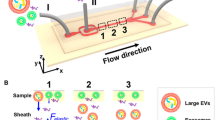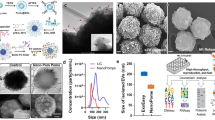Abstract
Objective
Exosomes are nano-scaled carriers of miRNA, mRNA and proteins which are secreted from viable cells. Exosome detection within serum, saliva and semen offers diagnostic value for detection of various diseases including cancer. In the present study, we have lunched an in vitro study to develop a more efficient method for exosome detection. In this regard, the recombinant LAMP-DARPins (capable of Her2 targeting) gene was packed within the lentiviral particles and stably transferred into the HEK293T cells. The morphology and sizes of the obtained exosomes were characterized by TEM and zeta sizer. The expression of LAMP-DARPins antigen on the exosome surface was verified by western blotting. Ultimately, the efficiency of cell surface ELISA in suspension method was examined for exosome detection.
Results
The exosome particles were successfully harvested and purified from transfected cells. The sizes of exosome particles were determined to be 90 nm using zeta sizer instrument. The TEM scan showed that the exosomes are cap like shaped and their sizes range between 40 and 150 nm. An observed 120 kDa band on western blotting paper indicated the LAMP-DARPins antigen expression on exosome surfaces. The results of cell surface ELISA in suspension method were superior to the results of conventional cell ELISA.
Conclusions
It could be concluded that the cell surface ELISA in suspension method could be an amenable method to detect exosome particles within the biological samples. Moreover, the method could be modified to evaluate the ability of exosomes to interact with target cells in both diagnostic and therapeutic applications.





Similar content being viewed by others
References
Alvarez-Erviti L, Seow Y, Yin H, Betts C, Lakhal S, Wood MJ (2011) Delivery of siRNA to the mouse brain by systemic injection of targeted exosomes. Nat Biotechnol 29:341
Boersma YL, Plückthun A (2011) DARPins and other repeat protein scaffolds: advances in engineering and applications. Curr Opin Biotechnol 22:849–857
Ciravolo V et al (2012) Potential role of HER2-overexpressing exosomes in countering trastuzumab-based therapy. J Cell Physiol 227:658–667
Hashemi ZS, Khalili S, Forouzandeh Moghadam M, Sadroddiny E (2017) Lung cancer and miRNAs: a possible remedy for anti-metastatic, therapeutic and diagnostic applications. Expert Rev Respir Med 11:147–157
Koyama Y, Ito T, Hasegawa A, Eriguchi M, Inaba T, Ushigusa T, Sugiura K (2016) Exosomes derived from tumor cells genetically modified to express Mycobacterium tuberculosis antigen: a novel vaccine for cancer therapy. Biotechnol Lett 38:1857–1866
Limoni SK, Moghadam MF, Moazzeni SM, Gomari H, Salimi F (2018) Engineered exosomes for targeted transfer of siRNA to HER2 positive breast cancer cells. Appl Biochem Biotechnol 187:1–13
Ludwig A-K, Giebel B (2012) Exosomes: small vesicles participating in intercellular communication. Int J Biochem Cell Biol 44:11–15
Mathivanan S, Ji H, Simpson RJ (2010) Exosomes: extracellular organelles important in intercellular communication. J Proteom 73:1907–1920
Michael A, Bajracharya SD, Yuen PS, Zhou H, Star RA, Illei GG, Alevizos I (2010) Exosomes from human saliva as a source of microRNA biomarkers. Oral Dis 16:34–38
Münch RC et al (2011) DARPins: an efficient targeting domain for lentiviral vectors. Mol Ther 19:686–693
Raimondo F, Morosi L, Chinello C, Magni F, Pitto M (2011) Advances in membranous vesicle and exosome proteomics improving biological understanding and biomarker discovery. Proteomics 11:709–720
Rountree RB et al (2011) Exosome targeting of tumor antigens expressed by cancer vaccines can improve antigen immunogenicity and therapeutic efficacy. Can Res 4076:2010
Schorey JS, Bhatnagar S (2008) Exosome function: from tumor immunology to pathogen biology. Traffic 9:871–881
Théry C, Amigorena S, Raposo G, Clayton A (2006) Isolation and characterization of exosomes from cell culture supernatants and biological fluids. Curr Protoc Cell Biol 30:21–23
Tian Y et al (2014) A doxorubicin delivery platform using engineered natural membrane vesicle exosomes for targeted tumor therapy. Biomaterials 35:2383–2390
Valadi H, Ekström K, Bossios A, Sjöstrand M, Lee JJ, Lötvall JO (2007) Exosome-mediated transfer of mRNAs and microRNAs is a novel mechanism of genetic exchange between cells. Nat Cell Biol 9:654
Vlassov AV, Magdaleno S, Setterquist R, Conrad R (2012) Exosomes: current knowledge of their composition, biological functions, and diagnostic and therapeutic potentials. Biochem Biophys Acta 1820:940–948
Wolfers J et al (2001) Tumor-derived exosomes are a source of shared tumor rejection antigens for CTL cross-priming. Nat Med 7:297
Yoshioka Y et al (2014) Ultra-sensitive liquid biopsy of circulating extracellular vesicles using ExoScreen. Nat Commun 5:3591
Zahnd C et al (2007) A designed ankyrin repeat protein evolved to picomolar affinity to Her2. J Mol Biol 369:1015–1028
Acknowledgements
The authors wish to thank Tarbiat Modares University and Iranian National Science Foundation for supporting the conduct of this research.
Author information
Authors and Affiliations
Corresponding author
Ethics declarations
Conflict of interest
All authors declare that they have no conflict of interest.
Ethical approval
This article does not contain any studies with human participants or animals performed by any of the authors.
Additional information
Publisher's Note
Springer Nature remains neutral with regard to jurisdictional claims in published maps and institutional affiliations.
Rights and permissions
About this article
Cite this article
Khodashenas, S., Khalili, S. & Forouzandeh Moghadam, M. A cell ELISA based method for exosome detection in diagnostic and therapeutic applications. Biotechnol Lett 41, 523–531 (2019). https://doi.org/10.1007/s10529-019-02667-5
Received:
Accepted:
Published:
Issue Date:
DOI: https://doi.org/10.1007/s10529-019-02667-5




